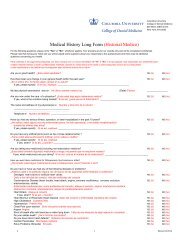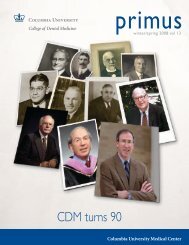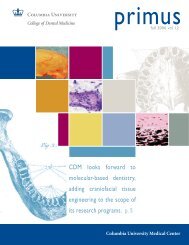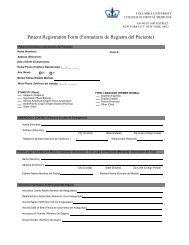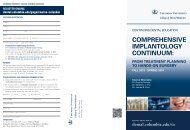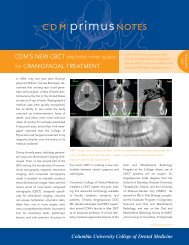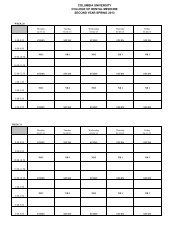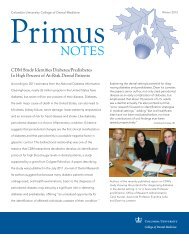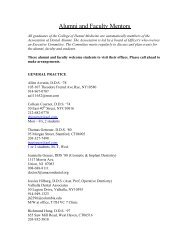Jarvie Journal - College of Dental Medicine - Columbia University
Jarvie Journal - College of Dental Medicine - Columbia University
Jarvie Journal - College of Dental Medicine - Columbia University
You also want an ePaper? Increase the reach of your titles
YUMPU automatically turns print PDFs into web optimized ePapers that Google loves.
The <strong>Journal</strong> <strong>of</strong> the William <strong>Jarvie</strong> Society<br />
Effect Of A Glutaraldehyde-Based Dentin Desensitizing Agent<br />
on the Retentive Strength <strong>of</strong> a Bioceramic Luting Cement<br />
Fransiskus Andrianto 1 , Julio Espinoza 2 , Anthony Randi 2 *<br />
1 Postgraduate Prosthodontic Program, <strong>College</strong> <strong>of</strong> <strong>Dental</strong> <strong>Medicine</strong>, <strong>Columbia</strong> <strong>University</strong>, NY, NY<br />
Division <strong>of</strong> Prosthodontics, <strong>College</strong> <strong>of</strong> <strong>Dental</strong> <strong>Medicine</strong>, <strong>Columbia</strong> <strong>University</strong>, New York, NY<br />
*Faculty Mentor<br />
Introduction: Dentinal desensitizing agents are frequently utilized after tooth preparation to prevent<br />
post-preparation sensitivity and prior to cementation to prevent post-cementation sensitivity.<br />
Nanostructurally Integrating Bioceramic (NIB) luting cement has been introduced recently. This dental<br />
material distinguishes itself from existing primary classes, such as resins and glass ionomers, and also<br />
from water-based cements, such as zinc phosphate cement. Minimal information has been published<br />
evaluating the retentive strength and solubility <strong>of</strong> this new class <strong>of</strong> luting cement<br />
Objective: To evaluate the effect <strong>of</strong> a glutaraldehyde-based dentin desensitizing agent on the retentive<br />
strength <strong>of</strong> this new class <strong>of</strong> luting cement compared to the other two self-etching resin cements.<br />
Materials & Methods: 72 freshly extracted molars were embedded in a stainless steel mounting ring<br />
with autopolymerizing acrylic resin. The occlusal surface <strong>of</strong> each mounted tooth was prepared flat 4 mm<br />
above the CEJ. A high speed handpiece secured in a milling apparatus on a dental surveyor with a<br />
diamond bur was oriented at an angle <strong>of</strong> 10º from a vertical axis to create a total convergence angle <strong>of</strong><br />
20º. The teeth were impressed with polyether and dies fabricated with type IV dental stone. Full crown<br />
wax patterns were made. The crowns were cast in Type III gold alloy. Metal/Zirconia Primer was<br />
applied in the internal surface <strong>of</strong> the castings, except for the Ceramir group. The teeth were divided into<br />
three groups. Each group was subdivided into 2 groups <strong>of</strong> 12 teeth. One group <strong>of</strong> 12 acted as the control<br />
for each cement. The other group received a gluteraldehyde desensitizig agent (Systemp®.desensitizer,<br />
Ivoclar Vivadent). Group I – single-step self-etching resin cement: RelyX Unicem, Group II – two-step<br />
self-etching resin cement: Multilink Automix and Group III – bioceramic luting cement: Ceramir.<br />
Specimens were stored in water for 24 hours and thermo-cycled between 5º C and 55º C for 2500 cycles<br />
with a 30-second dwell time. The crowns were subjected to an axial dislodgment force until failure using<br />
a universal testing machine at a cross head speed <strong>of</strong> 1 mm/minute. Failure was defined as dislodgement<br />
<strong>of</strong> the crown from the tooth preparation or fracture <strong>of</strong> the clinical crown or root. The force at<br />
dislodgment was recorded.<br />
Result: With the use <strong>of</strong> a glutaradeldehyde desensitizing agent, RelyX Unicem (37%) and Multilink<br />
Automix (24%) demonstrated decrease in bond strength. Ceramir demonstrated 27% increase in bond<br />
strength. Retentive results <strong>of</strong> the cements without desensitizing agents demonstrated bond strengths <strong>of</strong><br />
RelyX Unicem (913 N) > Multilink Automix (723 N) > Ceramir (470 N).<br />
Conclusion: The use <strong>of</strong> a gluteraldehyde desensitizing agent decreased the retentive strength <strong>of</strong> selfetching<br />
resin cements. RelyX Unicem exhibited higher failure loads than the 2-step Multilink Automix<br />
system.<br />
54



